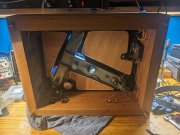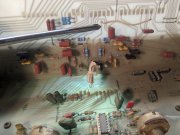The pin header is a convenient place to check rail voltage.
Hopefully Joe will comment about the output DC blocking caps.
Think I'm using the largest Panasonic ECW value there, 6.8 uF if I remember correctly. Mark L. is using a much larger value there.
As for the typo on the cap value, I'll have to look at my Series 2 manuals and see what they have entered.
The small films on the Browndogs are bypass caps, added because PL neglected to add these to the original design. Best way to apply bypass caps is between the opamps power supply pin and ground, with very short leads. Unfortunately there are no nearby grounds. The second best way to apply bypass caps is between the opamps two power supply pins, as the photo shows. Keep the leads as short as possible.
Adding the opamp bypass caps slightly decreased overall distortion as seen by a QuantAsylum QA403 Audio Analyzer during before and after testing
The S2 has improvements over the S1. I have one S1 board, and have only given it a casual look over. The only differences that stood out were the 4 drilled holes to mount the switch board. On the S2, these holes are silkscreened, but not drilled.
Working on my AR turntable and listening to The Allman Brothers.






